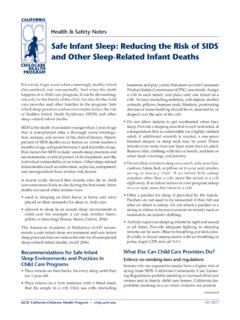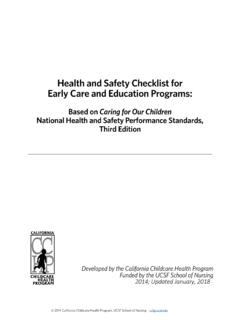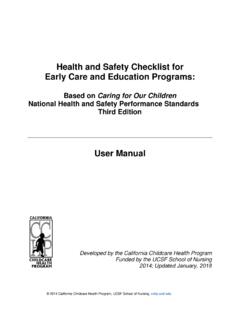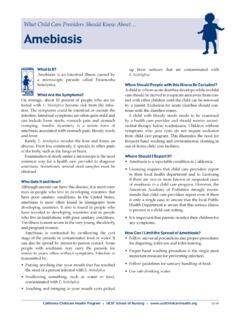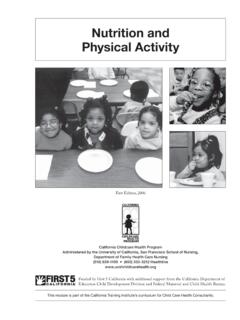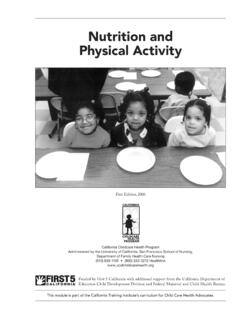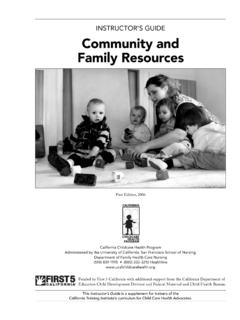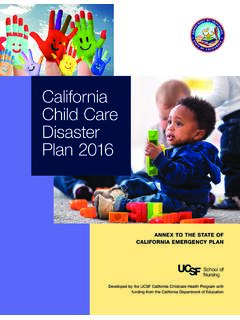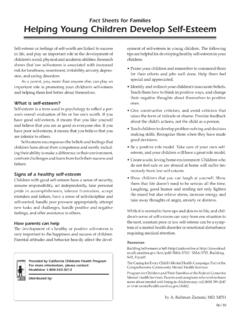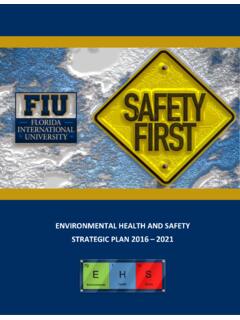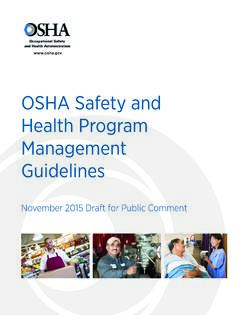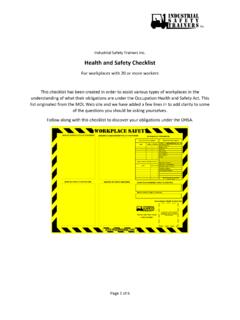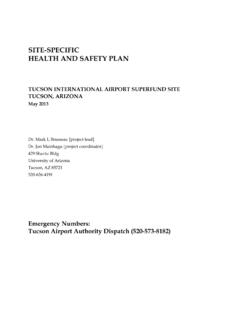Transcription of Health and Safety in the Child Care Setting: Prevention of ...
1 Health and Safety in the Child Care Setting: Prevention of InjuriesA Curriculum for theTraining of Child Care ProvidersModule 2 Second EditionDeveloped by The California Child Care Health Program1950 Addison Street, Suite 107 Berkeley, CA 94704-1182(510) 839-1195 Funded by a grant from The California Department of Education, Child Development DivisionJune 1998 Health and Safety in the Child Care Setting: Prevention of InjuriesA Curriculum for theTraining of Child Care ProvidersModule 2 Second EditionEditorial StaffA. Rahman Zamani, MD, MPHB ardy Anderson, Graphic ArtistSara Evinger, Editorial AssistantDesigned and edited by communicationsIn addition, we want to thank the staff and board membersof the California Childcare Health Programfor their support, ideas and patience during this labor of California Childcare Health Program is a community-oriented,multidisciplinary team dedicated to enhancing the quality of Child care forCalifornia s children by initiating and strengthening linkages among thehealth, Safety and Child care communities and the families they curriculum was revised November 2001.
2 Updated wish to thank the following persons who contributed their expertise and time to the production of this Bassoff, DSW, Consultant, California Childcare Health ProgramLyn Dailey, PHN, Child Care Health Consultant, California Childcare Health ProgramGail Gonzalez, RN, Child Care Health Consultant, California Childcare Health ProgramMarsha Sherman, MA, MFT, Director, California Childcare Health ProgramAndrea Azevedo, BDS, MPH, California Department of Health Services, Children Dental Disease Prevention ProgramRobert Bates, MD, California Department of Health Services, Maternal and Child , Health Branch, Childhood Injury Prevention ProgramElise Stone, MS, Health Education Coordinator, San Francisco Regional Poison Control CenterNadja Christian, Child Care Consultant, California Childcare Health Program Board MemberSara Woo, MPH, Project Coordinator, Child Passenger Safety Project, California Childcare Health ProgramTina Zenzola, MPH, Project Coordinator, Kids Plates, California Center for Childhood Injury PreventionCheryl Oku, Infant Toddler Specialist, California Childcare Health ProgramJudith Kunitz, Technical Assistant to the Linkages Project, California Childcare Health ProgramSome materials in this manual were adapted from materials obtained from the following organizations.
3 American Public Health Association and American Academy of Pediatrics under a grant from the Health Resources and Services Administration. Caring for Our Children - National Health and Safety Performance Standards: Guidelines for Out-of-Home Child Care Programs. Washington, DC: APHA & APA, due to be published 2001. Shapiro Kendrick, A., Kaufmann, R. and Messenger, , eds. Healthy Young Children. Washington, DC: National Association for the Education of Young Children, on Injury and Poison Prevention , American Academy of Pediatrics. Injury Prevention and Control for Children and Youth. Elk Grove Village, IL: American Academy of Pediatrics, Robertson. Safety , Nutrition, and Health in Early Education. Albany, New York: Delmar Publishers, Chapter, American Academy of Pediatrics.
4 Model Child Care Health Policies. PA: ECELS, American Academy of Pediatrics, 3rd Edition, June PageAbout the Curriculum 1 Trainer s Guide 2 How to Use This Module 3 Introduction 5 Section 1: Understanding Injuries in the Child Care Setting 7 Section 2: Risk of Injuries Related to Stages of Development 11 Section 3: Safety Policies and Behavior Management 17 Section 4: Regular Safety Checks of Indoor and Outdoor Environments 21 Section 5: Motor Vehicle, Transportation and Pedestrian Safety 27 Section 6: Child Abuse 37 Section 7: Sudden Infant Death Syndrome (SIDS) 43 Section 8: Burns and Fire 47 Section 9: Mechanical Airway Obstruction: Choking, Strangulation and Suffocation 51 Section 10: Falls 55 Section 11: Poisoning 61 Section 12.
5 Oral/Dental Injury 69 Section 13: Shaken Baby Syndrome 73 Section 14: Drowning 77 Section 15: Firearm Injuries 81 Section 16: Emergency Procedures 85 Section 17: Toy Safety 95 Section 18: Back Injury Among Providers 99 AppendicesResources iForms ixBibliography xvTable of ContentsCalifornia Childcare Health Program 1 This curriculum was fi rst published in June 1998 to be used by qualifi ed Health and Safety trainers to fulfi ll part of the learning needs and licensing requirements of Child care providers ( Health and Safety Code, Section ) in California. The core content of the Health and Safety training, based on Emergency Medical Services Authority (EMSA), is arranged into the following two modules: Module I Prevention of Infectious Disease Module II Prevention of InjuriesEach module stands on its own and has its own educational objectives and handouts.
6 Depending on the specifi c requirements, a smaller or larger number of learning objectives can be selected and the sequence of modules changed, or the objectives may be modifi ed. Contents of the curriculum and handouts are in agreement with the current Child care licensing regulations in California. This second and updated edition of Module 2, Prevention of Injuries, covers the content of the Emergency Medical Services Authority Child Care 7 Hours Preventive Health and Safety Training Course and will provide information and guidance on how to reduce and control injuries in the Child care setting. It also refl ects current changes in the National Health and Safety Performance Standards for Out-of-Home Child Care. By using this module, trainers will be able to: 1.
7 Increase awareness about the types of injuries are common in the Child care setting, who gets injured, how, when and why. 2. Help providers understand the connection between the developmental age of a Child and the kind of injuries he or she may have. 3. Discuss and develop Safety policies and use them as tools for Safety , risk Prevention and protection. 4. Encourage providers to accept responsibility for preventing injuries in their Child care setting. 5. Help providers to understand regular Safety checks and take actions to eliminate or reduce environmental hazards. 6. Provide materials that can be used as resources for Child care providers as well as Connect Child care providers with local Health and Safety the Curriculum2 Prevention of InjuriesTarget Audience: Child care providersGroup Size: 15-20 (ideal)Who Can Train?
8 Experienced Health and Safety trainers, registered nurses or licensed physicians with professional experience in injury control and Child care knowledge; trainers certifi ed by the Emergency Medical Services AuthorityMaterials Needed: Handouts and overheads (the handouts, overheadsand charts in this curriculum can be copied ontotransparencies and used as teaching tools as well ascopies for handouts to the students) VCR and monitor (if showing videos) Overhead projector (if using transparencies) First aid kit Disposable gloves Flip chart/chalkboard/whiteboardLength of Training: Three to fi ve hours. The length of time for individual topics depends on the learning needs and the trainer s preference for using transparencies, videos and/or demonstration.
9 Current California Child care regulations require 15 hours of Health and Safety training. The training in Prevention of Injuries is estimated to be three hours. This curriculum is designed to assist the trainer in meeting the requirement and in providing suffi cient information and resources to broaden the training to fi ve hours or more. The amount and focus of material selected is to be determined by the trainer. Trainer s GuideCalifornia Childcare Health Program 3 The target audience for this module is the Child care community. This module is simple to use, and the subject can be taught easily through instructions and suggestions provided in the Trainer Sheets. There is a Trainer Sheet at the beginning of each topic which covers goal/rationale, learning objectives, methods (learning strategies) to be used, materials and equipment required, and training time for each topic or section.
10 All handouts and overheads can be copied and distributed to participants. Some of them can be used as and trainers with questions on Child Health and Safety issues are encouraged to contact the Child Care Healthline at (800) 333-3212, or their county Health department. Including Parents in Creating a Healthy Environment Parents are the primary teachers and role models for young children. When parents are asked what is the most important thing they look for when seeking Child care, a healthy and safe environment is at the top of the list. With this in mind, Child care providers must include parents in their efforts to create healthy and safe environments and teach healthy habits to the children in their Child care Child care providers enrolled in the Health and Safety class may be new providers who are taking the course for the fi rst time or experienced providers who are repeating the class to refresh their knowledge and assure that they are up-to-date.
